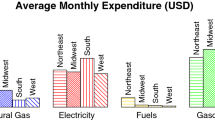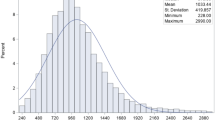Abstract
Variable-wise analysis operates on columns of a typical data matrix, while case-wise analysis operates on rows. In the latter, each observation is construed in the context of all other observations on the same case, and the analysis is biased toward the definition of ideal types. This article explores the potential of case-wise policy analysis using survey data on the burden of high energy costs at the household level. The case-wise and variable-wise alternatives are associated with different policy goals and result in quite different priorities for allocating public assistance to households most in need. The article concludes with a discussion of reasons for institutionalizing the case-wise alternative through periodic data collection and reporting systems.
Similar content being viewed by others
References
Allison, G. (1971). Essence of Decision: Explaining the Cuban Missile Crisis. Boston: Little, Brown.
Anton, T. J. and Larkey, P. D. et al. (1975). Understanding the Fiscal Impact of General Revenue-Sharing. Report to the National Science Foundation, Contract No. APR 75–03321. Ann Arbor: Institute of Public Policy Studies.
Beebout, H., Peabody, H. and Doyle, P. (1982). “The distribution of household energy expenditures and the impact of high prices,” in H. H. Landsberg (ed.), High Energy Costs: Assessing The Burden. Washington, D.C.: Resources for the Future, pp. 1–36.
Brewer, G. D. and Kakalik, J. S. (1979). Handicapped Children: Strategies for Improving Services. New York: McGraw-Hill.
Brown, S. R. (1980). Political Subjectivity: Applications of Q-Methodology in Political Science. New Haven: Yale University Press.
Brunner, R. D. (1982). “Comments on ‘Energy and Equity in a Broader Social and Economic Context’,” in H. H. Landsberg (ed.), High Energy Costs: Assessing the Burden. Washington, D.C.: Resources for the Future, pp. 220–225.
Burger, T. (1976). Max Weber's Theory of Concept Formation: History, Laws, and Ideal Types. Durham, NC: Duke University Press.
Campbell, D. T. (1977). “Focal local indicators for social program evaluation,” in Marcia Guttentag (ed.), Evaluation Studies Annual, Vol. 1. Beverly Hills, CA: Sage Publications.
Colorado Energy Research Institute (1981). Impact of Rising Energy Prices on Colorado Households: An Analysis and Policy Agenda. Lakewood, CO.
Colorado Energy Research Institute (n.d.). Unpublished draft documentation of the EPOCH model. Lakewood, CO.
Congressional Budget Office (1983a). National Gas Pricing Policies: Implications for the Federal Budget. Washington, D.C.: U.S. Government Printing Office.
Congressional Budget Office (1983b). Understanding Natural Gas Price Decontrol. Washington, D.C.: U.S. Government Printing Office.
Cooper, M. N. (1982). “Conceptualizing and measuring the burden of the high energy prices,” in H. H. Landsberg (ed.), High Energy Costs: Assessing the Burden. Washington, D.C.: Resources for the Future.
Hirsch, F. (1976). Social Limits to Growth. A Twentieth Century Fund Study. Cambridge: Harvard University Press.
Landsberg, H. H. (ed.) (1982). High Energy Costs: Assessing the Burden. Washington, D.C.: Resources for the Future.
Lasswell, H. D. (1938). “Intensive and extensive methods of observing the personality-culture manifold.” Yenching Journal of Social Studies 1: 72–86.
Lasswell, H. D. (1971). A Pre-View of Policy Sciences. New York. Elsevier.
Lasswell, H. D. and Kaplan, A. (1950). Power and Society. New Haven: Yale University Press.
Rein, M. (1976). Social Science and Public Policy. New York: Penguin.
Simon, H. A. (1957). Models of Man. New York: Wiley.
Simon, H. A. (1968). “Research for choice,” in R. Ewald Jr. (ed.), Environment and Policy: The Next Fifty Years. Bloomington: University of Indiana Press, pp. 360–380.
Simon, H. A. (1979). “How big is a chunk?” in his Models of Thought. New Haven: Yale University Press, pp. 50–61.
Sneath, P. H. A. and Sokal, R. R. (1973). Numerical Taxonomy: The Principles and Practice of Numerical Classification. San Francisco: W. H. Freeman.
Sui, R. G. H. (1978). “Management and the art of Chinese baseball,” Sloan Management Review 19: 83–89.
Tryon, R. C. and Bailey, D. E. (1970). Cluster Analysis. New York: McGraw-Hill.
Weber, M. (1949). Max Weber on the Methodology of the Social Sciences, E. A. Shils and H. A. Finch (eds. and trans.). Glencoe, Il: The Free Press.
Weiss, R. D. (1982). “Measuring the need for low-income energy assistance,” in H. H. Landsberg (ed.), High Energy Costs: Assessing the Burden. Washington, D.C.: Resources for the Future, pp. 121–125.
Author information
Authors and Affiliations
Rights and permissions
About this article
Cite this article
Brunner, R.D. Case-wise policy analysis: Another look at the burden of high energy costs. Policy Sci 16, 97–125 (1983). https://doi.org/10.1007/BF00138346
Issue Date:
DOI: https://doi.org/10.1007/BF00138346




